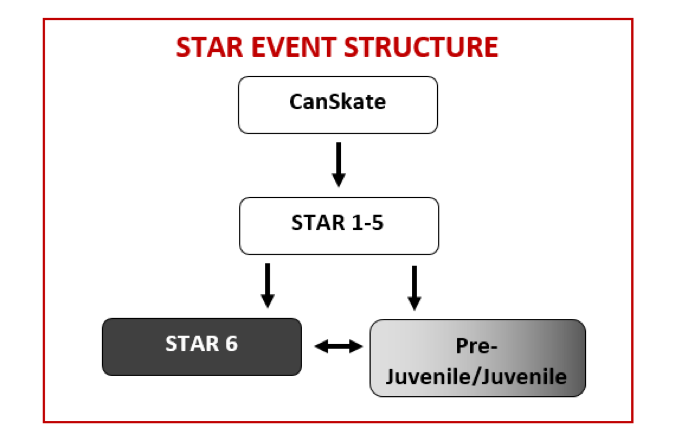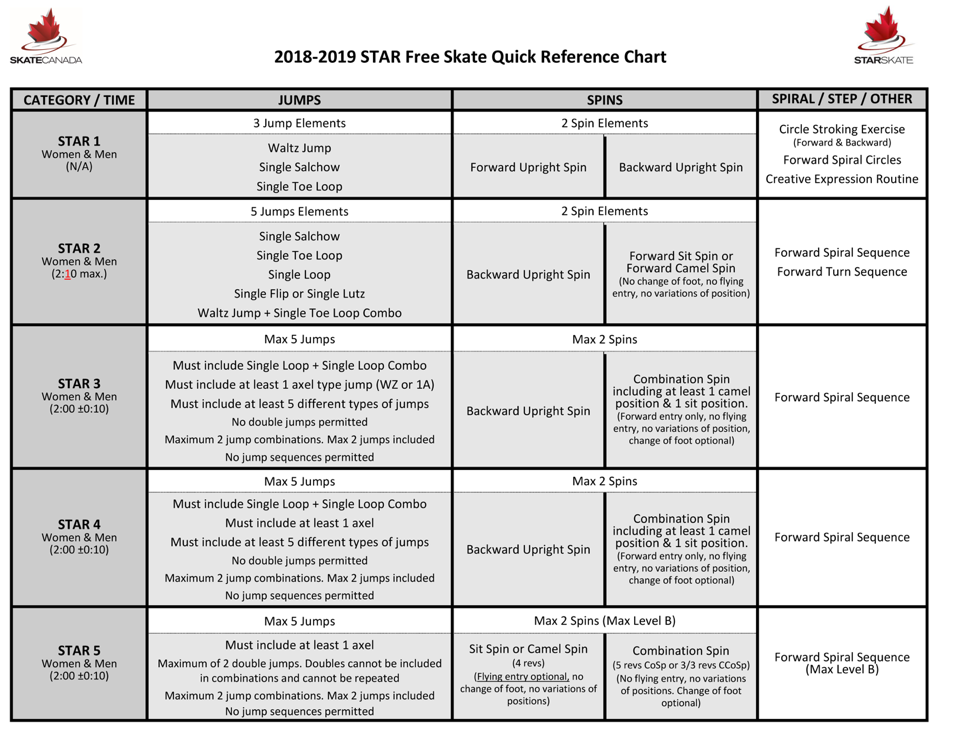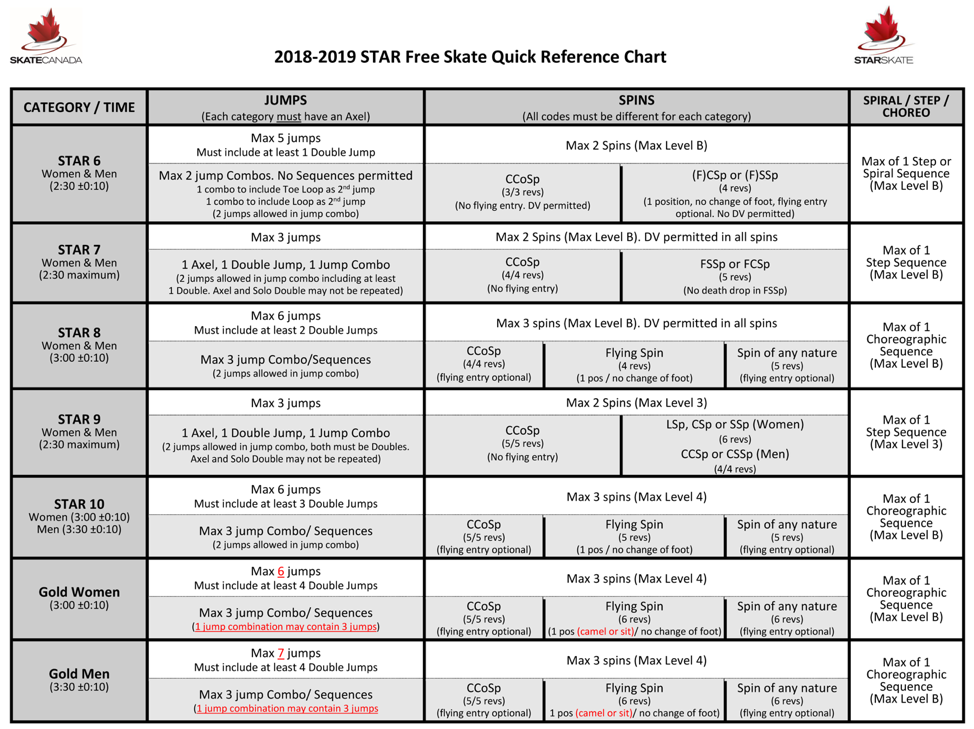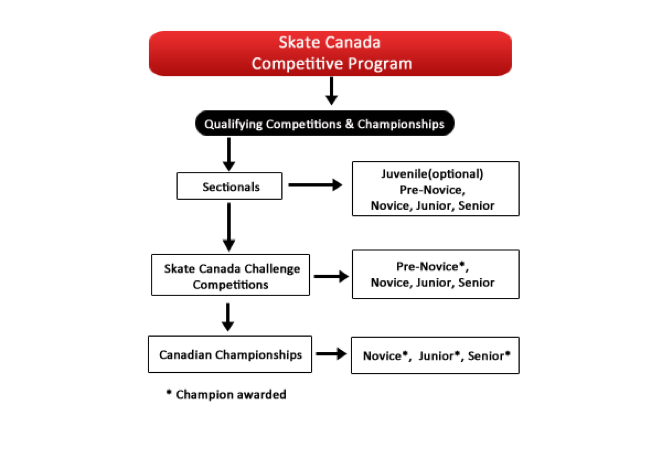Competitions
The Programs - Where do you Fit?
The following diagram outlines the programs we offer and the typical progression of a skater who starts at an early age and progresses to a senior skating level.
| Level of Difficulty | Level | Dance | Skills | Free Skate | Interpretive |
| 9 | Diamond | 6 dances | |||
| 8 | Gold | 5 dances | 3 skills | Elements & Program | Gold |
| 7 | Senior Silver | 5 dances | 3 skills | Elements & Program | Silver |
| 6 | Junior Silver | 4 dances | 3 skills | Elements & Program | |
| 5 | Senior Bronze | 3 dances | 3 skills | Elements & Program | Bronze |
| 4 | STAR 5 | 3 dances | 3 skills | Elements & Program | |
| 3 | STAR 3 | 3 dances | 3 skills | Elements & Program | Introductory |
| 2 | STAR 1 | ||||
| 1 | CanSkate | 6 badges |
STARSkate & Competitive Skate

STAR 1-5 Events
The STAR 1-5 event structure is intended to:- Align with the principles of LTAD
- Introduce theCPC judging system concepts to our youngest skaters
- Move skating away from 6.0 assessment system
- Put focus on training/skill acquisition versus competing for the sake of competing
- Make this level of the sport more affordable for participants and parents
- Take advantage of developing flexibility and speed between six and 10 years of age
- Encourage young skaters to start trying to interpret music
- Encourage skaters to acquire key skills (landing positions, stroking,) at an earlier age
- Align with the STAR 1-5 assessment program and provide external assessment in a safe environment
Overview of STAR 1-5
|
|
STAR 1 |
STAR 2 |
STAR 3 |
STAR 4 |
STAR 5 |
|
Format |
Group |
Individual |
Individual |
Individual |
Individual |
|
Content |
Elements |
Free Program |
Free Program |
Free Program |
Free Program |
|
Results |
Assessed to Standard |
Assessed to Standard |
Assessed to Standard |
Assessed to Standard and Ranked |
Ranked |
- As skaters’ progress in level, the STAR 1-5 system progresses:
- From a group to an individual format
- From performing elements in isolation to performing a free program
- From being assessed to a standard to being ranked
- The intent is for skaters to compete at the level that is right for them at the right time
- STAR 1-5 skaters should move between levels as appropriate
- Skaters can move between multiple levels in one season
Assessment to Standard
Skaters in STAR 1-4 will be assessed against a standard for each element and program component. The following table describes the correlation between the assessment standards of Gold, Silver, Bronze and Merit with the expected level of development of skaters.
|
GOLD |
SILVER |
BRONZE |
MERIT |
|
Performance exceeds development standard for level |
Performance is at development standard for level |
Performance is slightly below development standard for level |
Performance is significantly below development standard for level |
Judges always need to keep in mind that the expected level of development is different for each level of STAR. The expected level of development for a STAR 4 skater is much higher than a STAR 2 skater, for example. The same single Salchow performed in a STAR 2 and a STAR 4 event would not necessarily receive the same rating. This element might meet the standard for a Gold in STAR 2 but might only meet the standard for a Silver in STAR 4 as the skater has a higher expected level of development.
STAR 5
Skaters in STAR 5 are no longer assessed against a standard as in STAR 1-4. In STAR 5, skaters will be ranked within their groups and will be judged using the Cumulative Points Calculation (CPC) system.- Each element (i.e. jump, spin or step sequence) is worth a specific point value
- In some elements, skaters can increase the point value by adding difficulty to their elements
- Skaters are also assessed on fourprogram components
- A skater receives a Total Score at the end of his/her performance that is made up of a Technical Score and a Program Component He/she receives a detailed scorecard with scores for each element and program component from each judge
- Technical Panel: Identifies elements and determines the difficulty level of certain elements (also identifies falls and bonuses as applicable).
- Judging Panel: Assigns quality marks to eachelement (Grades of Execution or GOEs) (also applies deductions as applicable). The judging panel also assigns program component scores for five aspects of a skater’s program.
STAR Stream
This is the recreational stream. It is possible to participate in out-of region competition [usually STAR 2 and higher] and qualify for the Provinical Finals Michel Proulx for categories STAR 5 and higher. The qualification event will take place during the regional competition held in January.
Categories and requirements
Badge 4- Must wear a helmet
- No music
- No music
STAR 1 to STAR 5

STAR 6 to GOLD

Categories are based on technical level as well as age. Skaters need to be aware that required test elements differ from the minimum requirements for competition events. The STAR test is usually much easier than the competition requirements. Skaters are expected to compete at their true ability level.

Sectional events are held for juvenile, pre-novice, novice, junior and senior competitors. For pre-novice, novice, junior and senior competitors, these are the qualifying competitions for Skate Canada Challenge. Sectional competitions are held annually in each of the 10 Sections.
Pre-Juvenile and Juvenile competitors at the Skate Canada Sectionals do not progress any further.
The top placements in pre-novice, novice junior and senior advance to the Skate Canada Challenge.
Categories and requirements
Sans-Limites [7, 8, 9, 10 years], consult the following link:
Pre-Juvenile, Juvenile, Pre-Novice, Novice, Junior, Senior consult the following:
https://info.skatecanada.ca/index.php/en-ca/guides/244-program-requirements-quick-reference-guides-2018-2019.html



